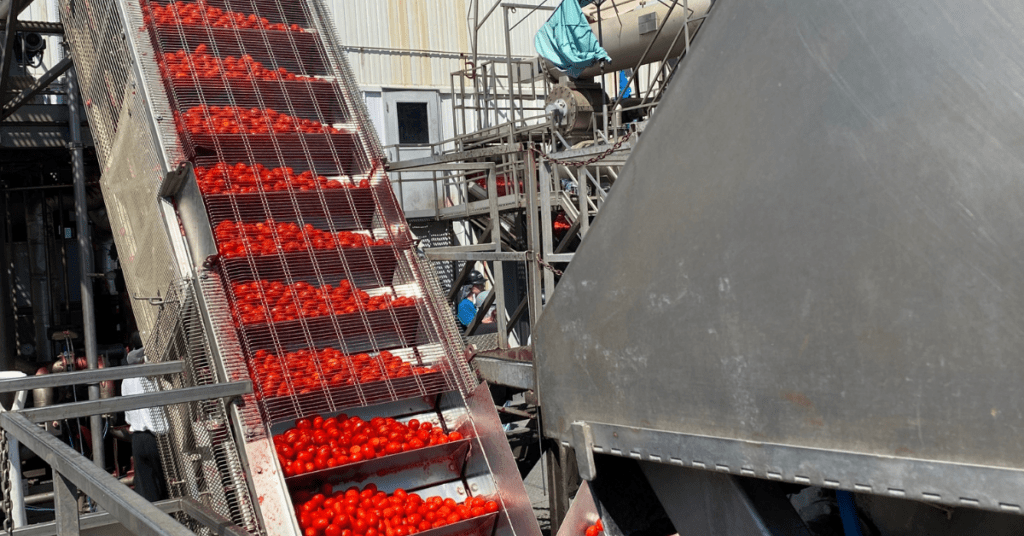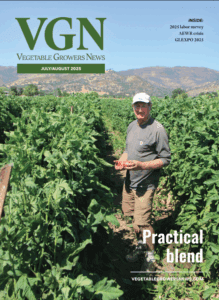
Nov 22, 2024Pacific Coast Producers focuses on sustainable production from farm to can
When it comes to fruit and vegetable production, California is America’s superpower. The state’s ideal climate for vegetable production helps make it the third largest producer of processed tomatoes in the world.
Pacific Coast Producers is one major regional producer. Sixteen of its 150 family farms grow and can 50% of all private label tomatoes produced in North America within the Central and Northern California region.

In recent years, the company has ramped up its focus on more sustainable production, and its sustainability story provides an example of big results from small changes — from field to can.
Boosting sustainable production in the field
Frank Muller and his family have been farming in Sacramento Valley for more than 50 years. Muller is owner of M Three Ranches and chair of Pacific Coast Producers, and is recognized as a leader in the production of organically and conventionally grown field crops, especially tomatoes.
Muller, his two sons, and Rudy Lucero, district manager of tomato field operations, work to produce high-value crops as sustainably as possible. This means reducing reliance on pesticides and herbicides, carefully managing water usage and adopting technology that helps reduce waste and greenhouse gas emissions.
Each season, Lucero meets with the managers of Pacific Coast Producers’ processing plant and provides them with a list of 30 varieties to choose from. Varieties are selected, in part, based on the ability to adapt to climate variability. The process has paid off, as the past three years have been drought years.
To boost water-use efficiency, Muller invested in drip irrigation. His decision to do so was based on University of California, Davis studies that showed tomatoes need a lot less water than previously thought. The investment cost $1,500 per acre but cut water usage by 40% and increased yields by 25%.

An investment in harvest equipment with camera technology has enabled better sorting of tomatoes and the removal of foreign material quickly and efficiently. Using sorting technology has allowed M Three Ranches to reduce waste and improve the quality of the crop delivered to the processor.
Previously, sorting was done manually, which was costly and less efficient. Only two workers are needed to manage the new harvest equipment. “We have to be really cognizant of our labor costs, because labor is our number-one cost,” said Muller.
To improve soil and environmental health, Muller practices crop rotation, uses compost in place of synthetic fertilizer where possible, and combines the two when needed. He also practices integrated pest management strategies that reduce reliance on pesticides.
“The goal is to leave the farm better off than how we found it,” Muller said.
Five hours from field to can
From its location Woodland, California, M Three Ranches is less than 10 miles away from Pacific Coast Producers’ Woodland processing plant. In fact, 96% of the processor’s conventional tomatoes are harvested within a 17-mile radius.
Harvested tomatoes leave the field still warm from the sun and go straight to the factory for processing. From field to can, the entire process takes approximately five hours.

Tomatoes go through several processes before they land in the can. First, loads are inspected for defects, color and character by an independent state grading system, then rinsed and floated out of the truck. From there, tomatoes are bathed and sent through a steam peeling process.
It’s at this point where another investment has boosted the company’s sustainability profile.
In 2019, the California Energy Commission awarded Pacific Coast Producers a $5.7 millionå grant through the Food Production Investment Program under the state’s climate investment program. The grant was used to install advanced energy-efficient evaporation technology.
Chris Ward, manager of the Woodland plant where the technology was installed said the technology has been a game-changer for the company.
Tomatoes are approximately 95% water and 5% solids and sugars, he said. Converting tomato juice to paste requires the evaporation of 80% of the water content.

This is done through the use of a massive evaporator, which causes heat from steam to evaporate excess water. Using mechanical vapor recompression technology, Pacific Coast Producers is able to raise pressure and temperature and then recycle the steam back into the process.
The technology not only reduces the use of fossil fuels but also lowers water consumption. The exhaust from the peeling process is then used as process steam.
“We’re basically using steam to create one-third of our energy load before we start the heating process,” Ward said.
According to a California Climate Investments report, the technology saves more than 70,000 kilowatt- hours and more than $1 million annually. The combined energy reductions avoid over 8,000 metric tons of carbon dioxide equivalent emissions annually as well, a result that improves air quality in the heavily populated area.
The process also allows the processor to reuse the removed peel, reducing overall waste.
Traditional peeling methods rely on lye, a process that makes the use of removed peel unsafe. Steam peeling tomatoes also helps retain quality in terms of texture and color. It also increases overall yield.
“We actually used to be about 65 cases per ton, and now we’re producing, on average, at 74 cases per ton,” Ward said.
Once the tomatoes are steam peeled, they are sorted by size and color in the plant. Some are kept whole, while others are diced, crushed or made into sauces, paste, juice, ketchup or marinara sauces. Following that, tomatoes are sorted once again using state-of-the-art technology and placed in different- sized cans, ranging from 6- to 105-ounce cans.
Some of Pacific Coast Producers’ final products are packaged in plastic. It’s not ideal, but it’s what some customers want, said Andy Russick, vice president of sales and marketing.
“We’re figuring out how to use plastic with 30% post-consumer recycled (PCR) material,” he said. “The manufacturers were giving us this non-see through product that just wasn’t holding up. But they feel that someday we could be using up to 90% PCR in our plastic.”
Once canned and seamed, the tomatoes are sent to a giant pressure cooker and cooked to seal in nutrients. This is where that extra steam comes in handy, as it reduces reliance on fossil fuels. Once cooked and cooled, the cans are assessed to ensure weight, flavor and other attributes meet specifications. Finally, they’re shipped off to a distribution center to be labeled, cased and shipped.
Within the complex production process of getting tomatoes to supermarket shelves, Pacific Coast Producers has found ways to boost sustainability by carefully managing water usage and adopting technology that helps reduce waste, energy and greenhouse gas emissions.
Written by By Melanie Epp, Contributing Writer
















